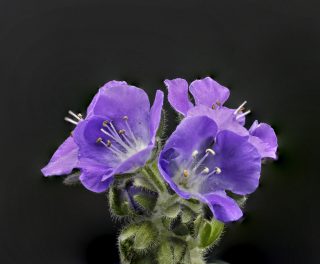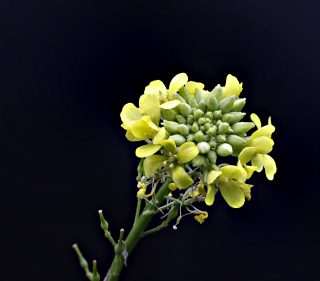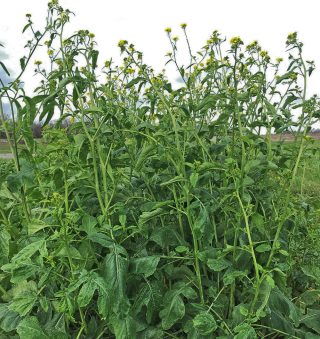
One of the early wildflowers is the pretty Blue Phacelia. It reminds me that the Texas Bluebonnets are not far behind! Robert Benson photo.
The War of the Rosettes
Did I just see a hint of blue in my wildflower bed? Could the Bluebonnets be starting to bloom already?
A closer look revealed that these flowers were not the same shade of blue as Bluebonnets. In fact, they looked almost purple. I decided that they were not bluebonnets but another blue wildflower: Blue Phacelia. It used to be known as Purple Phacelia. It blooms early, often by late February. By May, the phacelia are finished. Still, they are lovely and prolific while they last, and they hint of things to come. Besides, I noticed several rosettes (circles of leaves at ground level) of Bluebonnets nearby. Bluebonnets will be blooming soon!
Another early-bloomer along roadsides is Bastard Cabbage. With a name like that, you can be sure it is NOT a favorite of wildflower enthusiasts. I think it looks pretty, though, with its airy spray of yellow flowers over broad green leaves. Sometimes it is the greenest thing around in late February. It grows to five feet tall, often in large groups, in meadows and waste areas. To me it is a harbinger of spring. But it is not a native plant in Texas. Bastard Cabbage (Rapistrum rugosum) hails from the Eurasian steppes. It was most likely introduced as a contaminant in grass seed mixes. Bastard Cabbage seeds are about the same size as rye and other grass seeds and weed seed screens cannot remove them. However, it got here, and Bastard Cabbage now occurs in 17 states. The International Plant Atlas of the United States (IPAUS) classifies Rapistrum rugosum as an invasive in this country.
What exactly does it mean to be an invasive species? The definition of an invasive species is a “species that is 1) non-native (alien) to the ecosystem under consideration, and 2) whose introduction causes or is likely to cause economic or environmental harm or harm to human health.” From what I can find out, Bastard Cabbage causes environmental harm by crowding out our native wildflowers, particularly Bluebonnets. Oh no! A threat to our iconic Texas wildflower!

Each Bastard Cabbage plant produces numerous branching stems of bright yellow flowers. Notice the little ball-shaped seedpods, each with a pointed beak, along this stem. Another name for this plant is “Ball Mustard.” Robert Benson photo.
Bastard Cabbage seeds germinate in the late fall and early winter and grow quickly. They easily outgrow and out-compete native plants by forming a broad rosette of thick leaves close to the ground. Bluebonnets also sprout in fall and grow a basal rosette of leaflets. But Bluebonnets’ rosettes are more delicate in nature. These robust leafy rosettes of Bastard Cabbage cover a square foot or more of soil. This prevents other native wildflowers from getting a start, so what results is a monoculture of Bastard Cabbage. In early spring, these plants flower and “bolt to seed” dispersing those seeds along roadsides, ditches and disturbed areas. And they produce a lot of seeds; I counted 23 seedpods on just one stem of Bastard Cabbage. This plant is now “becoming invasive in natural areas such as open forest and along streams.”
Bastard Cabbage is a member of the Mustard Family of plants. This family includes broccoli, mustard greens, cabbage, arugula, and a number of wild mustards. You may be familiar with peppergrass, a common wildflower/weed. The leaves and seedpods have a biting pungency that can be used to flavor foods. Peppergrass is an edible native mustard plant that has sometimes been called “Poor Man’s Pepper.” Likewise, Bastard Cabbage is edible (especially while the leaves are young) and was featured on the foragedfoodie.blogspot.com website. Indeed, Texas Monthly (August 18, 2012) published an article entitled “Texas’s Five Most Delicious Invasive Species.” Bastard Cabbage was number four on the list!
Bastard Cabbage really needs a new name. Some suggestions include Common Giant Mustard, Ball Mustard (for the shape of its seedpods), and Turnip-weed. Wouldn’t you be more comfortable eating Turnip-weed instead of Bastard Cabbage?
The idea of eating invasive species is catching on. They have even coined a name for one who eats invasives: Invasivore! The Foraged Foodie suggests an Indian dish known as Chana Masala made with Bastard Cabbage. You can find recipes for Feral Hog with a side of Braised Bastard Cabbage. Mexican food aficionados take note: There is also Feral Hog Guisada (take a 50-lb feral hog….) Nutria Chili and Fajitas Carpitas (a kind of fish taco made with Asian Carp).

Seeds of the invasive Bastard Cabbage germinate in late fall and produce wide rosettes of robust leaves. Each rosette can cover more than a square foot of ground. The rosette blocks sunlight and nutrients to other native wildflowers trying to get a start during the winter. In February, Bastard Cabbage “bolts to seed” and can get five feet high. Karen Benson photo.
If you are faced with too much Bastard Cabbage to eat it all, you can just pull it up (preferably before it flowers). The Lady Bird Johnson Wildflower Center recommends you seed the area with native wildflowers after removing the invasive. In 2005, a researcher with the Wildflower Center, Mark Simmons, found that “Bastard Cabbage populations were dramatically reduced in areas heavily seeded with one of our top native wildflowers, Indian Blanket (Gaillardia pulchella).
I like it: Fight plants with plants! Or as the botanists say: Let’s let native plants get an advantage over the “bastards”. If not, we can always eat them!
03/02/2018 – Column by Karen L. P. Benson
